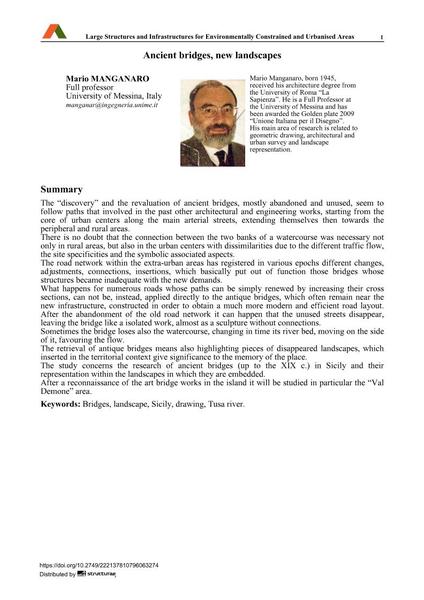Ancient bridges, new landscapes

|
|
|||||||||||
Bibliographic Details
| Author(s): |
Mario Manganaro
|
||||
|---|---|---|---|---|---|
| Medium: | conference paper | ||||
| Language(s): | English | ||||
| Conference: | IABSE Symposium: Large Structures and Infrastructures for Environmentally Constrained and Urbanised Areas, Venice, Italy, 22-24 September 2010 | ||||
| Published in: | IABSE Symposium Venice 2010 | ||||
|
|||||
| Page(s): | 666-667 | ||||
| Total no. of pages: | 8 | ||||
| Year: | 2010 | ||||
| DOI: | 10.2749/222137810796063274 | ||||
| Abstract: |
The “discovery” and the revaluation of ancient bridges, mostly abandoned and unused, seem to follow paths that involved in the past other architectural and engineering works, starting from the core of urban centers along the main arterial streets, extending themselves then towards the peripheral and rural areas. There is no doubt that the connection between the two banks of a watercourse was necessary not only in rural areas, but also in the urban centers with dissimilarities due to the different traffic flow, the site specificities and the symbolic associated aspects. The road network within the extra-urban areas has registered in various epochs different changes, adjustments, connections, insertions, which basically put out of function those bridges whose structures became inadequate with the new demands. What happens for numerous roads whose paths can be simply renewed by increasing their cross sections, can not be, instead, applied directly to the antique bridges, which often remain near the new infrastructure, constructed in order to obtain a much more modern and efficient road layout. After the abandonment of the old road network it can happen that the unused streets disappear, leaving the bridge like a isolated work, almost as a sculpture without connections. Sometimes the bridge loses also the watercourse, changing in time its river bed, moving on the side of it, favouring the flow. The retrieval of antique bridges means also highlighting pieces of disappeared landscapes, which inserted in the territorial context give significance to the memory of the place. The study concerns the research of ancient bridges (up to the XIX c.) in Sicily and their representation within the landscapes in which they are embedded. After a reconnaissance of the art bridge works in the island it will be studied in particular the “Val Demone” area. |
||||
| Keywords: |
bridges landscape drawing Sicily Tusa river
|
||||
